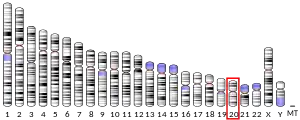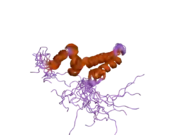DNAJC5
DnaJ homolog subfamily C member 5, also known as cysteine string protein or CSP is a protein, that in humans encoded by the DNAJC5 gene.[5] It was first described in 1990.[6]
| DNAJC5 | |||||||||||||||||||||||||||||||||||||||||||||||||||
|---|---|---|---|---|---|---|---|---|---|---|---|---|---|---|---|---|---|---|---|---|---|---|---|---|---|---|---|---|---|---|---|---|---|---|---|---|---|---|---|---|---|---|---|---|---|---|---|---|---|---|---|
 | |||||||||||||||||||||||||||||||||||||||||||||||||||
| |||||||||||||||||||||||||||||||||||||||||||||||||||
| Identifiers | |||||||||||||||||||||||||||||||||||||||||||||||||||
| Aliases | DNAJC5, CLN4, CLN4B, CSP, DNAJC5A, NCL, mir-941-2, mir-941-3, mir-941-4, mir-941-5, DnaJ heat shock protein family (Hsp40) member C5 | ||||||||||||||||||||||||||||||||||||||||||||||||||
| External IDs | OMIM: 611203 MGI: 892995 HomoloGene: 9631 GeneCards: DNAJC5 | ||||||||||||||||||||||||||||||||||||||||||||||||||
| |||||||||||||||||||||||||||||||||||||||||||||||||||
| |||||||||||||||||||||||||||||||||||||||||||||||||||
| |||||||||||||||||||||||||||||||||||||||||||||||||||
| |||||||||||||||||||||||||||||||||||||||||||||||||||
| Wikidata | |||||||||||||||||||||||||||||||||||||||||||||||||||
| |||||||||||||||||||||||||||||||||||||||||||||||||||
Gene
In humans, the gene is located on the long arm of chromosome 20 (20q13.33) on the Watson (positive strand). The gene is 40,867 bases in length and the encoded protein has 198 amino acids with a predicted molecular weight of 22.149 kiloDaltons (kDa). The weight of the mature protein is 34kDa.
This gene is highly conserved and found both in invertebrates and vertebrates. In humans, a pseudogene of this gene is located on the short arm of chromosome 8.
Structure
The organisation of the protein is as follows:[7]
- an N-terminus phosphorylation site for protein kinase A
- a J domain (~70 amino acids)
- a linker region
- a cysteine motif consisting of 13–15 cysteines within a stretch of 25 amino acids. It is heavily palmitoylated in the cysteine string motif.
- a less conserved C-terminal domain
Tissue distribution
This protein is abundant in neural tissue and displays a characteristic localization to synaptic and clathrin coated vesicles. It is also found on secretory vesicles in endocrine, neuroendocrine and exocrine cells. This protein makes up ~1% of the protein content of the synaptic vesicles.[8] DNAJC5 appears to have a role in stimulated exocytosis.[9]
Function
The encoded protein is a member of the J protein family. These proteins function in many cellular processes by regulating the ATPase activity of 70 kDa heat shock proteins (Hsp70). DNAJC5 is a guanine nucleotide exchange factor for Gα proteins.[10] CSPα plays a role in membrane trafficking and protein folding, and has been shown to have anti-neurodegenerative properties. It is known to play a role in cystic fibrosis and Huntington's disease.[5]
This protein has been proposed as a key element of the synaptic molecular machinery devoted to the rescue of synaptic proteins that have been unfolded by activity dependent stress.[11][12] Syntaxin 1A, a plasma membrane SNARE (soluble N-ethylmaleimide-sensitive factor attachment protein receptor) critical for neurotransmission, forms a complex with CSPα, a G protein and an N-type calcium channel. Huntingtin may be able displace both syntaxin 1A and CSPα from N-type channels.[13] CSP interacts with the calcium sensor protein synaptotagmin 9 via its linker domain.[14]
Huntingtin-interacting protein 14, a palmitoyl transferase, is required for exocytosis and targeting of CSP to synaptic vesicles. The palmitoyl residues are transferred to the cysteine residues. If these resides are mutated membrane targeting is reduced or lost.[15] The rat CSP forms a complex with Sgt (SGTA) and Hsc70 (HSPA8) located on the synaptic vesicle surface. This complex functions as an ATP-dependent chaperone that reactivates denatured substrates. Furthermore, the Csp/Sgt/Hsc70 complex appears to be important for maintenance of normal synapses.[7]
Its expression may be increased with the use of lithium.[16] Quercetin promotes formation of stable CSPα-CSPα dimers.[17]
Cysteine-string protein increases the calcium sensitivity of neurotransmitter exocytosis.[18]
Interactions
DNAJC5 has been shown to interact with the cystic fibrosis transmembrane conductance regulator.[19]
Clinical significance
Mutations in this gene may cause neuronal ceroid lipofuscinosis.[20]
References
- GRCh38: Ensembl release 89: ENSG00000101152 - Ensembl, May 2017
- GRCm38: Ensembl release 89: ENSMUSG00000000826 - Ensembl, May 2017
- "Human PubMed Reference:". National Center for Biotechnology Information, U.S. National Library of Medicine.
- "Mouse PubMed Reference:". National Center for Biotechnology Information, U.S. National Library of Medicine.
- "Entrez Gene: DNAJC5 DnaJ (Hsp40) homolog, subfamily C, member 5".
- Zinsmaier KE, Hofbauer A, Heimbeck G, Pflugfelder GO, Buchner S, Buchner E (November 1990). "A cysteine-string protein is expressed in retina and brain of Drosophila". J. Neurogenet. 7 (1): 15–29. doi:10.3109/01677069009084150. PMID 2129171.
- Tobaben S, Thakur P, Fernández-Chacón R, Südhof TC, Rettig J, Stahl B (September 2001). "A trimeric protein complex functions as a synaptic chaperone machine". Neuron. 31 (6): 987–99. doi:10.1016/S0896-6273(01)00427-5. hdl:11858/00-001M-0000-0012-F746-0. PMID 11580898. S2CID 12386691.
- Benitez BA, Alvarado D, Cai Y, Mayo K, Chakraverty S, Norton J, Morris JC, Sands MS, Goate A, Cruchaga C (2011). "Exome-Sequencing Confirms DNAJC5 Mutations as Cause of Adult Neuronal Ceroid-Lipofuscinosis". PLOS ONE. 6 (11): e26741. doi:10.1371/journal.pone.0026741. PMC 3208569. PMID 22073189.
- Ranjan R, Bronk P, Zinsmaier KE (February 1998). "Cysteine string protein is required for calcium secretion coupling of evoked neurotransmission in drosophila but not for vesicle recycling". J. Neurosci. 18 (3): 956–64. doi:10.1523/JNEUROSCI.18-03-00956.1998. PMC 6792780. PMID 9437017.
- Bai L, Swayne LA, Braun JE (January 2007). "The CSPalpha/G protein complex in PC12 cells". Biochem. Biophys. Res. Commun. 352 (1): 123–9. doi:10.1016/j.bbrc.2006.10.178. PMID 17113038.
- Fernández-Chacón R, Wölfel M, Nishimune H, Tabares L, Schmitz F, Castellano-Muñoz M, Rosenmund C, Montesinos ML, Sanes JR, Schneggenburger R, Südhof TC (April 2004). "The synaptic vesicle protein CSP alpha prevents presynaptic degeneration". Neuron. 42 (2): 237–51. doi:10.1016/S0896-6273(04)00190-4. PMID 15091340. S2CID 15604376.
- Chandra S, Gallardo G, Fernández-Chacón R, Schlüter OM, Südhof TC (November 2005). "Alpha-synuclein cooperates with CSPalpha in preventing neurodegeneration". Cell. 123 (3): 383–96. doi:10.1016/j.cell.2005.09.028. PMID 16269331. S2CID 18173864.
- Swayne LA, Beck KE, Braun JE (September 2006). "The cysteine string protein multimeric complex". Biochem. Biophys. Res. Commun. 348 (1): 83–91. doi:10.1016/j.bbrc.2006.07.033. PMID 16875662.
- Boal F, Laguerre M, Milochau A, Lang J, Scotti PA (January 2011). "A charged prominence in the linker domain of the cysteine-string protein Cspα mediates its regulated interaction with the calcium sensor synaptotagmin 9 during exocytosis". FASEB J. 25 (1): 132–43. doi:10.1096/fj.09-152033. PMID 20847230. S2CID 7494452.
- Chamberlain LH, Burgoyne RD (October 1998). "The cysteine-string domain of the secretory vesicle cysteine-string protein is required for membrane targeting". Biochem. J. 335 (2): 205–9. doi:10.1042/bj3350205. PMC 1219770. PMID 9761715.
- Cordeiro ML, Umbach JA, Gundersen CB (June 2000). "Lithium ions enhance cysteine string protein gene expression in vivo and in vitro". J. Neurochem. 74 (6): 2365–72. doi:10.1046/j.1471-4159.2000.0742365.x. PMID 10820197. S2CID 19687617.
- Xu F, Proft J, Gibbs S, Winkfein B, Johnson JN, Syed N, Braun JE (2010). "Quercetin targets cysteine string protein (CSPalpha) and impairs synaptic transmission". PLOS ONE. 5 (6): e11045. doi:10.1371/journal.pone.0011045. PMC 2883571. PMID 20548785.
- Dawson-Scully K, Bronk P, Atwood HL, Zinsmaier KE (August 2000). "Cysteine-string protein increases the calcium sensitivity of neurotransmitter exocytosis in Drosophila". J. Neurosci. 20 (16): 6039–47. doi:10.1523/jneurosci.20-16-06039.2000. PMC 6772598. PMID 10934253.
- Zhang H, Peters KW, Sun F, Marino CR, Lang J, Burgoyne RD, Frizzell RA (August 2002). "Cysteine string protein interacts with and modulates the maturation of the cystic fibrosis transmembrane conductance regulator". J. Biol. Chem. 277 (32): 28948–58. doi:10.1074/jbc.M111706200. PMID 12039948.
- Nosková L, Stránecký V, Hartmannová H, Přistoupilová A, Barešová V, Ivánek R, Hůlková H, Jahnová H, van der Zee J, Staropoli JF, Sims KB, Tyynelä J, Van Broeckhoven C, Nijssen PC, Mole SE, Elleder M, Kmoch S (August 2011). "Mutations in DNAJC5, encoding cysteine-string protein alpha, cause autosomal-dominant adult-onset neuronal ceroid lipofuscinosis". American Journal of Human Genetics. 89 (2): 241–52. doi:10.1016/j.ajhg.2011.07.003. PMC 3155175. PMID 21820099.
Further reading
- Chamberlain LH, Burgoyne RD (2000). "Cysteine string protein: the chaperone at the synapse". J. Neurochem. 74 (5): 1781–1789. doi:10.1046/j.1471-4159.2000.0741781.x. PMID 10800920. S2CID 7667658.
- Mastrogiacomo A, Parsons SM, Zampighi GA, Jenden DJ, Umbach JA, Gundersen CB (1994). "Cysteine string proteins: a potential link between synaptic vesicles and presynaptic Ca2+ channels". Science. 263 (5149): 981–82. doi:10.1126/science.7906056. PMID 7906056.
- Gundersen CB, Mastrogiacomo A, Faull K, Umbach JA (1994). "Extensive lipidation of a Torpedo cysteine string protein". Journal of Biological Chemistry. 269 (30): 19197–19199. doi:10.1016/S0021-9258(17)32151-8. PMID 8034679.
- Mastrogiacomo A, Gundersen CB (1995). "The nucleotide and deduced amino acid sequence of a rat cysteine string protein". Molecular Brain Research. 28 (1): 12–18. doi:10.1016/0169-328x(94)00172-b. PMID 7535880.
- Coppola T, Gundersen C (1996). "Widespread expression of human cysteine string proteins". FEBS Lett. 391 (3): 269–72. doi:10.1016/0014-5793(96)00750-8. PMID 8764987. S2CID 10410573.
- Zhang H, Kelley WL, Chamberlain LH, et al. (1999). "Mutational analysis of cysteine-string protein function in insulin exocytosis". J. Cell Sci. 112 (9): 1345–51. doi:10.1242/jcs.112.9.1345. PMID 10194413.
- Hattori A, Okumura K, Nagase T, et al. (2001). "Characterization of long cDNA clones from human adult spleen". DNA Res. 7 (6): 357–66. doi:10.1093/dnares/7.6.357. PMID 11214971.
- Evans GJ, Wilkinson MC, Graham ME, et al. (2002). "Phosphorylation of cysteine string protein by protein kinase A. Implications for the modulation of exocytosis". J. Biol. Chem. 276 (51): 47877–85. doi:10.1074/jbc.M108186200. PMID 11604405.
- Deloukas P, Matthews LH, Ashurst J, et al. (2002). "The DNA sequence and comparative analysis of human chromosome 20". Nature. 414 (6866): 865–71. Bibcode:2001Natur.414..865D. doi:10.1038/414865a. PMID 11780052.
- Strausberg RL, Feingold EA, Grouse LH, et al. (2003). "Generation and initial analysis of more than 15,000 full-length human and mouse cDNA sequences". Proc. Natl. Acad. Sci. U.S.A. 99 (26): 16899–903. Bibcode:2002PNAS...9916899M. doi:10.1073/pnas.242603899. PMC 139241. PMID 12477932.
- Miller LC, Swayne LA, Chen L, et al. (2004). "Cysteine string protein (CSP) inhibition of N-type calcium channels is blocked by mutant huntingtin". J. Biol. Chem. 278 (52): 53072–81. doi:10.1074/jbc.M306230200. PMID 14570907.
- Ota T, Suzuki Y, Nishikawa T, et al. (2004). "Complete sequencing and characterization of 21,243 full-length human cDNAs". Nat. Genet. 36 (1): 40–5. doi:10.1038/ng1285. PMID 14702039.
- Giorgianni F, Beranova-Giorgianni S, Desiderio DM (2004). "Identification and characterization of phosphorylated proteins in the human pituitary". Proteomics. 4 (3): 587–98. doi:10.1002/pmic.200300584. PMID 14997482. S2CID 25355914.
- Gerhard DS, Wagner L, Feingold EA, et al. (2004). "The Status, Quality, and Expansion of the NIH Full-Length cDNA Project: The Mammalian Gene Collection (MGC)". Genome Res. 14 (10B): 2121–7. doi:10.1101/gr.2596504. PMC 528928. PMID 15489334.
- Boal F, Zhang H, Tessier C, et al. (2005). "The variable C-terminus of cysteine string proteins modulates exocytosis and protein-protein interactions". Biochemistry. 43 (51): 16212–23. doi:10.1021/bi048612+. PMID 15610015.
- Natochin M, Campbell TN, Barren B, et al. (2005). "Characterization of the G alpha(s) regulator cysteine string protein". J. Biol. Chem. 280 (34): 30236–41. doi:10.1074/jbc.M500722200. PMID 15972823.
- Zhang H, Schmidt BZ, Sun F, et al. (2006). "Cysteine string protein monitors late steps in cystic fibrosis transmembrane conductance regulator biogenesis". J. Biol. Chem. 281 (16): 11312–21. doi:10.1074/jbc.M512013200. PMID 16469739.
- Chi A, Valencia JC, Hu ZZ, et al. (2007). "Proteomic and bioinformatic characterization of the biogenesis and function of melanosomes". J. Proteome Res. 5 (11): 3135–44. doi:10.1021/pr060363j. PMID 17081065.




